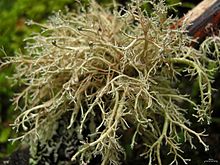| Sphaerophoraceae | |
|---|---|

| |
| Sphaerophorus venerabilis | |
| Scientific classification | |
| Kingdom: | Fungi |
| Division: | Ascomycota |
| Class: | Lecanoromycetes |
| Order: | Lecanorales |
| Family: | Sphaerophoraceae Fr. (1831) |
| Type genus | |
| Sphaerophorus Pers. (1794)
| |
| Genera | |
|
Austropeltum | |
| Synonyms[1] | |
The Sphaerophoraceae are a family of lichenized fungi in the order Lecanorales. Species of this family have a widespread distribution, especially in southern temperate regions.[3] Sphaerophoraceae was circumscribed by mycologist Elias Magnus Fries in 1831.[4]
Genera[edit]
Sphaerophoraceae contains 6 genera and 39 species. Following the genus name is the taxonomic authority, year of publication, and the number of species:[5]
- Austropeltum Henssen, H.Döring & Kantvilas (1992)[6] – 1 sp.
- Bunodophoron A.Massal. (1861) – 25 spp.
- Calycidium Stirt. (1877)[7] – 2 spp.
- Leifidium Wedin (1993)[8] – 1 sp.
- Neophyllis F.Wilson (1891)[9] – 2 spp.
- Sphaerophorus Pers. (1794) – 8 spp.
References[edit]
- ^ Lücking, Robert; Hodkinson, Brendan P.; Leavitt, Steven D. (2017). "The 2016 classification of lichenized fungi in the Ascomycota and Basidiomycota – Approaching one thousand genera". The Bryologist. 119 (4): 361–416. doi:10.1639/0007-2745-119.4.361. S2CID 90258634.
- ^ Elenkin (1929). "O teoreticheskikh printsipakh detalizatsii osnovnykh ryadov kombinativnoi sistemy lishainikov" [On the theoretical grounds of detailed elaboration of basic series of the combinative system of lichens]. Izvestiya Glavnogo Botanicheskogo Sada SSSR ('Bulletin Jardin Botanique de l'URSS') (in Russian). 28: 265–305.
- ^ Cannon PF, Kirk PM (2007). Fungal Families of the World. Wallingford, UK: CABI. p. 334. ISBN 978-0-85199-827-5.
- ^ Fries, E.M. (1831). Lichenographia Europaea Reformata (in Latin). Lundin: typis Berlingianis, venditur apud E. Mauritium, Gryphiae. p. 7.
- ^ Wijayawardene, N.N.; Hyde, K.D.; Dai, D.Q.; Sánchez-García, M.; Goto, B.T.; Saxena, R.K.; et al. (2022). "Outline of Fungi and fungus-like taxa – 2021". Mycosphere. 13 (1): 53–453. doi:10.5943/mycosphere/13/1/2. S2CID 249054641.
- ^ Henssen, A.; Döring, H.; Kantvilas, G. (1992). "Austropeltum glareosum gen. et sp. nov., a new lichen from Mountain Plateaux in Tasmania and New Zealand". Botanica Acta. 105 (6): 457–467. doi:10.1111/j.1438-8677.1992.tb00328.x.
- ^ Stirton, J. (1877). "On new genera and species of lichens from New Zealand". Proceedings of the Philosophical Society of Glasgow. 10: 285–306.
- ^ Wedin, Mats (1993). "A phylogenetic analysis of the lichen family Sphaerophoraceae (Caliciales); a new generic classification and notes on character evolution". Plant Systematics and Evolution. 187 (1–4): 213–241. doi:10.1007/bf00994100.
- ^ Wilson, F.R.M. (1891). "On lichens collected in the Colony of Victoria, Australia". Botanical Journal of the Linnean Society. 28: 353–374 [372].